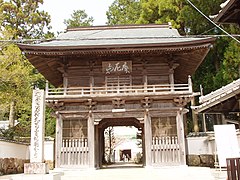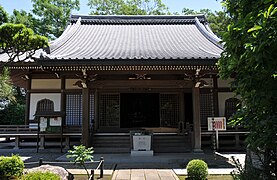Tosa Kokubun-ji
The Tosa Kokubun-ji ( Japanese 土 佐 国 分 寺 ), with the mountain name Manizan ( 摩尼 山 ) and the sub-temple name Hōzō-in ( 宝 蔵 院 ) in the city of Nankoku ( Kōchi Prefecture ), is a temple of the Chisan branch ( 智 山 派 Chisan-ha ) of Shingon Buddhism . In the traditional count, it is the 29th temple on the Shikoku pilgrimage route .
history
The Tosa Kokubun-ji was established by priest Gyōki during the reign of Emperor Shōmu between 724 and 749 as a provincial temple ( Kokubunji ), d. H. Main temple of the province of Tosa . In 815, priest Kūkai passed here on his pilgrimage through Shikoku and made a sculpture of St. Bishamonten for the small rear temple building, Okuin ( 奥 院 ). On the occasion, the secret ceremony for the expulsion of evil ( 星 供 の 秘 法 Hoshiku no hihō ) was performed in the main hall . Since then, the temple has been known as the location for this ceremony, as Hoshiku kompon dōjō ( 星 供 の 根本 道場 ).
investment
You enter the temple in the south through the temple gate, which is designed here as a two-story "Niō gate" ( 仁王 門 Niō-mon ; 1), ie as a two-story gate with the two temple guards ( Niō ) to the right and left of the passage. It should be a foundation of the 2nd Prince ( Daimyō ) of Tosa, Yamanouchi Tadayoshi ( 山 内 忠義 ; 1592-1665). You pass the temple bell on the right ( 鐘楼 Shōrō ; 2), on the left the pavilion commemorating the founding of the temple ( 開山 堂 Kaisandō ; 3) and then you have the main hall ( 本 堂 Hondō ; 4) in front of you.
The main hall was built by the then rulers in the area, Chōsokabe Kunichika ( 長 宗 我 部 国親 ; 1504-1560) and son Chōsokabe Motochika , in 1558 as a replacement for the previous building and is registered as an important cultural asset of Japan . The building is 5 ken wide and 6 ken deep. The roof is covered with thin shingles ( 杮 葺 き Kokerabuki ) and is reminiscent of the roofs of the Tempyō period, i.e. the 8th century. In 1932 the temple was dismantled and restored in seven years of work. From 1966, and then again in 1995, the roof was renewed. - To the left is the hall for the worship of the temple founder, the Daishidō ( 大師 堂 ; 5) from 1634. Originally the roof like the main hall was covered with thin shingles, in 1960 these were replaced by copper sheet.
On the way from the temple gate to the main hall, a path branches off to the right after the temple bell. You pass the middle gate ( 中 門 Chūmon ; 8) and on your left you have the garden (G) of the abbey residence. In this garden, planted with sickle firs, there are basestones of the temple's pagoda on moss ground or gravel, which have been moved here. Among the memorial stones in the garden there is one with a waka inscription from the mother of the Romanist Asabuki Tomiko ( 朝 吹 登 水 子 ; 1917–2005). Next to it is the guest house ( 客 殿 Kyakuden ; 6), which was built in 1973 to replace the building from the Edo period , and ahead of the Kōmyō-den ( 光明 殿 ; 7), which was completed in 1995 as a place of prayer for the blind and infirm.
The tree-lined southeastern part of the temple grounds contains remains of the original Kokubun-ji and is registered at the national level as a "Historical Trace" ( 国 歴 史跡 Kuni rekishi ato ). From the original temple with an east-west extension of 500 Shaku (151.5 m) and a north-south extension of 450 Shaku (136.4 m), remains of the ramparts have been preserved on the eastern edge. This is 1.5 to 2 m high and 3 to 4 m wide.
To the left of Kokubun-ji is the Kokubu-Sōsa-Shrine ( 国 府 総 社 神社 -jinja ; S).
Treasures
Among the temple treasures are some important cultural assets , two statues of Yakushi Nyorai , the healing Buddha. One is from the late Heian period and is one of the oldest in the prefecture. It is 95.5 cm high and made from one piece of Hinoki . The other is from the Kamakura period and is 35.5 cm tall. The base was originally gilded and contains an inscription indicating that it was repaired in 1406.
Another important cultural asset is a temple bell ( 梵 鐘 Bonshō ) with a height of 63.8 cm, an opening of 47 cm and a weight of 225 kg. There is no inscription on it, but it is dated to the early Heian period.
photos
Remarks
- ↑ The temple is also called "Moss Temple of Tosa" ( 土 佐 の 苔 寺Tosa no Kokedera ) in allusion to the famous Kokedera in Kyoto .
literature
- Kōchi-ken kotogakko kyoiku kenkyukai rekishi bukai (Ed.): Kokubunji . In: Kōchi-ken no rekishi sampo. Yamakawa Shuppan, 2006. ISBN 978-4-634-24639-3 . Page 95.
- Oguri, Doei: Kukai. Shikoku hachijuhachi kosho no arukikata. Chukei no Bunko, 2011. ISBN 978-4-8061-4067-2 .
Web links
Coordinates: 33 ° 35 ′ 55.3 " N , 133 ° 38 ′ 25.5" E
← Previous Temple: Dainichi-ji | Tosa Kokubun-ji | Next temple: Zenraku-ji →







